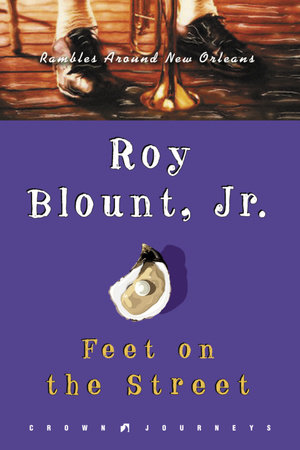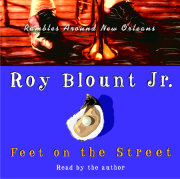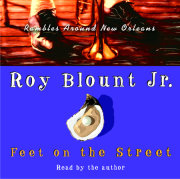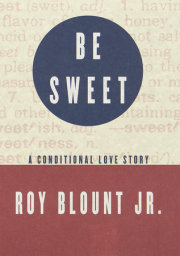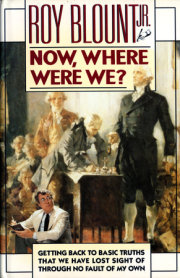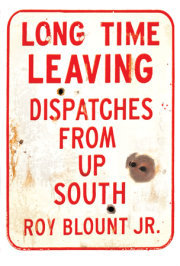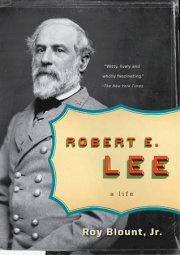Ramble One: OrientationMitch: I thought you were straight.
Blanche: What’s straight? A road or a line can be straight. But the human heart?
—A Streetcar Named DesireSince the Mississippi flows generally south from its origin in Minnesota to the Gulf of Mexico, you expect a town on the river to be on the east bank or the west. But at New Orleans the river flows eastwardly, sort of, so New Orleans is on the north bank, sort of. On the other side of the river is an area known, to be sure, as West Bank, but most of it lies either south or east of the river. On a map you can see: if the river were straight, New Orleans would be almost horizontal, right to left, east to west, between the river to the south and Lake Pontchartrain (as big as Rhode Island) to the north. But the river is crooked. The best known parts of New Orleans form a sort of tipped-forward
S along bends in the river, from Uptown and the Garden District through Downtown, the French Quarter, and on around eastward into Fauxborg Marigny and the Bywater. Within this
S, Uptown is south (upriver) and Downtown north (downriver), because the river takes a northerly hitch. However, the part of the Quarter that is farthest downtown is referred to as the upper Quarter, though I have heard it called the lower.
So when I tell you that I am pretty damn sure that in 1998, during Hurricane Georges, I saw the river, at least the topmost layer of it, flowing backward (because the wind was blowing so hard southerly along that northerly hitch), you can see why I might not be absolutely sure.
It was late and I was by myself at the time, nobody else was around. And I was feeling let down, because although the wind was blowing hard, and half the population had been evacuated, and thousands who’d stayed had been herded into the Superdome for their safety, and my friend Greg Jaynes and I had taken refuge in the shuttered-up Burgundy Street home of my friend Curtis Wilkie, it was clear that this was not going to be the Big One: the full force of Georges was going to miss us.
We knew this from Nash Roberts. Nash Roberts is a veteran New Orleans TV weatherman who is low-tech, at least by way of presentation, and always right. Nash was broadcasting from his own house, it looked like, tracing the hurricane with a grease pencil on a sheet of Plexiglas or a pad of paper, I forget which, while the other channels’ meteorologists were using all manner of laser pointers and rear-projected electronic schematic representations of the area. You couldn’t tell what in the world Nash was scribbling with the grease pencil, but as usual he was the first to make the call, this one’s going to miss us, and he was on the money.
So I felt I could venture outside and take a look at the river, and when I did, it was going backward. I’m pretty damn sure.
Ordinarily, at any rate, when you face the river from the French Quarter you’ll see the river flowing from your right to your left. As recently as the late sixties, early seventies, when Kermit Ruffins was a kid in New Orleans—he’s a fixture in the city now as a jazz musician—he’d catch crabs from the river, to eat. “Get some string, tie a chicken leg on it, and when that string get real tight, pull in real slow—scoop ’em up and put ’em in the bucket. End of the day we might have a hundred, hundred-fifty crabs.” You wouldn’t want to eat anything out of the river here now; it’s filthy with silt and petrochemicals. But it’s a robust presence. John Barry, author of
Rising Tide, a terrific book about the horrific flood of 1927 (which the New Orleans elite managed to divert onto poorer folks’ lands) says the river is “perfect,” as opposed to the imperfect people who try to make it behave. It’s a little like the horse that the New Orleans “swamp blues” musician Coco Robichaux told me about, which kept walking into a post, over and over. “What are you doing trying to sell a blind horse?” somebody said. “He ain’t blind,” said the man who was trying to sell him. “He’s just tough. He don’t care.”
The river is perfect because it doesn’t care. It would just as soon drown New Orleans, or any other place, as not. But people, being imperfect, want to believe that it cares. People call it “Old Man River,” “The Father of Waters.” Big dirty thruster barreling into town.
And New Orleans, née
La Nouvelle Orleans, is ready to take him on. Not “ready” in the sense that she has pulled herself together for their ultimate date yet (efforts are under way to figure out how to build a wall or something), but she wouldn’t be herself if she were all squared away. Stephanie Dupuy, a native New Orleanian, once quoted Billy Wilder on Marilyn Monroe to relevant effect here. Stephanie and I were in Jennifer Flowers’s club listening to her sing “Happy Birthday” in a breathy voice, and let it be said that she, who had a long affair with Bill Clinton, did not belabor the allusion by singing it explicitly to “Mr. President.” Stephanie works out of the mayor’s office, coordinating with people making movies in the city. She says that when movie people come to New Orleans, they say the same thing Meyer Lansky said when he discovered Batista’s Cuba: “At last, a government I can work with.” Stephanie knows Hollywood lore. She says that when people on the set of
Some Like It Hot were complaining that Marilyn was always late, Wilder, the director, said this: “I have an aunt in Austria who is always on time. You want her to play the part?”
Orientation. You’re in the French Quarter looking at the river. Now turn around and repeat this mnemonic:
Dixie
Cups,
Rock ’n’
Bowl,
Ducks
By
Ruthie. The Dixie Cups were a sweet and snappy New Orleans trio, two sisters and a cousin, who knocked the Beatles off the top of the charts with “Chapel of Love” and had another big hit with “Iko, Iko,” the old Mardis Gras chant. (New Orleans has a long history of musical families, the Boswells, the Nevilles, the Marsalises, Harry Connick Jr. and Sr.—senior having retired as the city’s district attorney to appear as “the singing DA.”) Rock ’n’ Bowl is an uptown bowling alley (Mid-City Lanes) that is also where you can dance till all hours to, say, the zydeco stylings of Boozoo Chavis. And Ruthie is perhaps the most famous French Quarter character, who used to rollerskate around the Quarter followed by a string of ducks.
D is for Decatur,
C for Chartres,
R for Royal,
B for Bourbon,
D for Dauphine,
B for Burgundy (pronounced with the accent on gun),
R for Rampart, the long streets of the Quarter in order.
The order of the short streets that cross the long ones may be borne in mind as follows: “
C’mon,
I’ll
Be
Cool,
Sugar,
Take
Something
Off—
Something
Dainty,
Some
Underwear—
Go,
Baby,
Everything!” Canal, Iberville, Bienville, Conti, St. Louis, Toulouse, St. Peter, Orleans, St. Ann, Dumaine, St. Philip, Ursulines, Governor Nichols, Barracks, Esplanade. To keep the sequence of the saint streets straight, remember, Louis, Peter, Ann, Philip: “
Let’s
Party
And
Party.” These are my own mnemonics, which may not suit everyone, but you are welcome to share them.
We will walk beyond the Quarter, but this is the old city, the Vieux Carré, the central, original, the part of the city that is most . . . how shall I put it? The music critic Will Friedwald praises Connie Boswell’s singing as follows: “Unlike [Mildred] Bailey’s thin, delicate wisp, which, though charming, represented a coy middle-American attitude toward sex, Boswell’s is a more directly sensual, genuinely vaginal instrument, something else [aside from the influence of Louis Armstrong] she picked up in New Orleans.” It is said that the French founders of the city, when they couched its name in the feminine gender, as opposed to
Le Nouveau, were making a bit of a joke: the Duke of Orleans, for whom it was named, was known to wear women’s underwear. But if a city may be regarded as having a sex, surely Chicago for instance is male, New Orleans female. And the Quarter, for all the rectilinearity of its grid, is the most vaginal part of town.
Lagniappe with Orientation: Genifer FlowersFor a time early in the twenty-first century, she and her husband Finis D. (forgive me if I have the middle initial wrong) Shelnut operated a club in the Quarter where she sang. I had a chat with her between sets, a good-looking woman not at all stuck up. She sang pretty, too. “It Was Just One of Those Things,” which she modified slightly for two patrons who said they were from Buffalo (“a trip to the moon on Buffalo wings”), and “You Make Me Feel Like a Natural Woman.” Shelnut himself stood over in a corner listening. J.F. winked at him and said, “My husband went to the doctor, wasn’t feeling good. The doctor said, ‘You need to have sex five times a week.’ My husband told me, and I said, ‘Put me down for two of those.’ ” Finis (pronounced Fine-iss) produced an enigmatic smile. In the audience, dancing to the music, wearing a round red hat snugly attached to a brunette wig, was the lively octogenarian Verita Thompson, who had earlier presided over a club on the same site called Bogie and Me, in reference to her having been Humphrey Bogart’s mistress, an association evolving from her service as custodian of his toupee: “She was his hairist,” said Stephanie Dupuy, who introduced us as Verita boogied by. A man standing near us jumped. “I’ve just been groped by an eighty-year-old woman,” he confided.
Rock ’n’ BowlAn event that was scheduled for that venue in 2002, according to Bunny Matthews in OffBeat:
Ernie K-Doe has never let a minor obstacle like death get in the way of his imperial career. His widow, Antoinette K-Doe, is producing an extravaganza on September 20. . . . At approximately 8:30 p.m., the wax statue of K-Doe will be transported via the Mother-in-Law Van from the Mother-in-Law Lounge to Mid-City Lanes. . . . At the bowling alley, the statue will be transferred to the K-Doemobile (a vehicle based on the Popemobile) and escorted into the club, attended by the Paradise Ladies (Antoinette and Uptown snowball stand proprietress T-Eva) and the Cleopatra Ladies (a bevy of dancers . . .). Inside Rock ’n’ Bowl, music will be provided by the Blue-Eye Soul Band, Al “Carnival Time” Johnson, Oliver “Who Shot the La La?” Morgan, Rico Watts (impersonating Elvis Presley) . . . And, at some point in the evening, Antoinette will don a wedding gown à la Priscilla Presley and the wax rendition of K-Doe will sing “White Boy/Black Boy” and “Children of the World.” Don’t ask me how.HurricanesA hurricane, as it approaches New Orleans or lurks offshore, becomes a character in the local media and in local conversation (for instance Isidore, of 2002, seen as sulking, lumbering, fickle), its arc and potential a matter of debate and speculation, as if the storm were a candidate for public office. Very little dread seems to enter into the discussion—for one thing, as the Louisiana novelist Jim Wilcox observes, hurricanes are a great relief from the heat. However, he says, “There is nothing like the heat the day after a hurricane.”
Copyright © 2005 by Roy Blount, Jr.. All rights reserved. No part of this excerpt may be reproduced or reprinted without permission in writing from the publisher.

